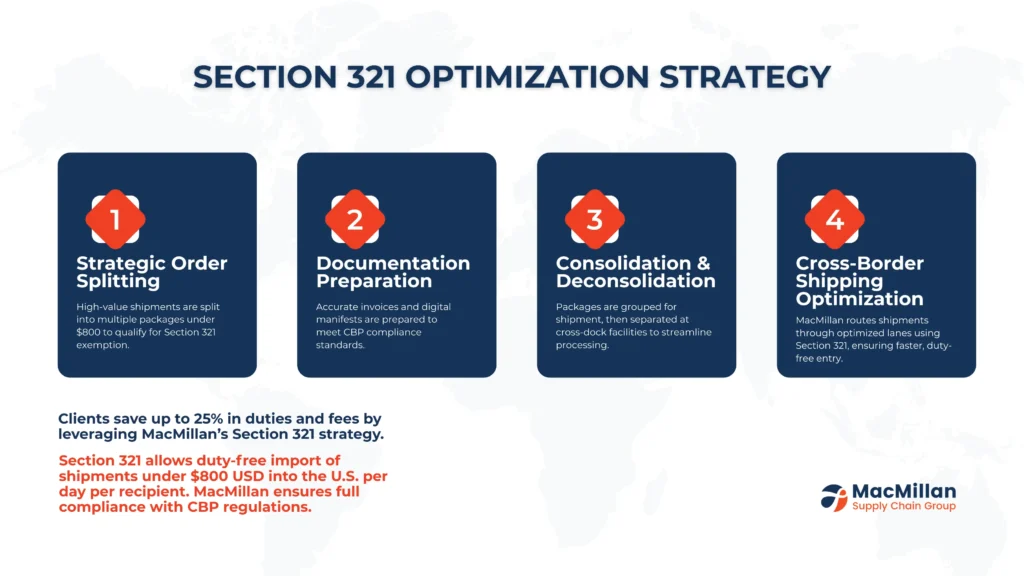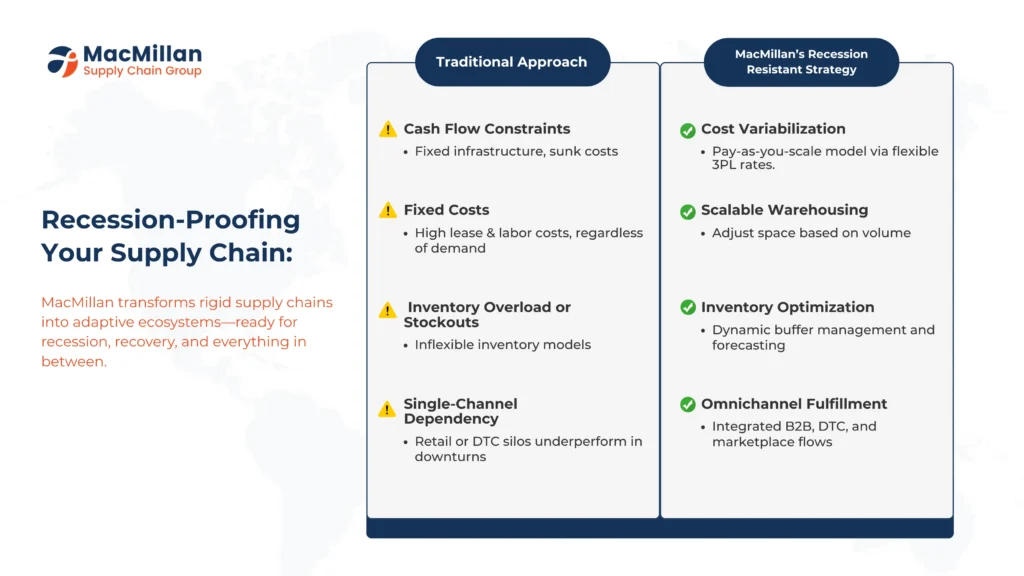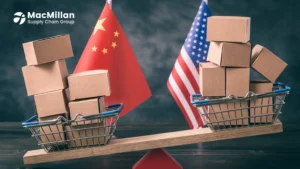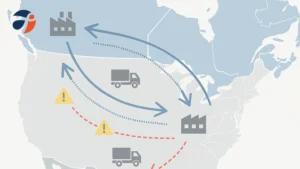A quick summary and overview
Businesses incur increased expenses that may jeopardize profitability when governments impose tariffs on imported goods. Businesses on both sides of the border now face additional difficulties as a result of the recent tariff bill that affects trade between the United States and Canada. These tariffs raise the risk of a recession when combined with earlier trade restrictions. Nonetheless, there is a strategic benefit to working with a Canadian 3PL like MacMillan Supply Chain Group. Our proficiency in warehouse management, Section 321 optimization, and cross-border logistics can assist you in overcoming these obstacles while cutting expenses. This article describes how our 3PL services in Toronto, Ontario, and throughout Canada can shield your company from the effects of tariffs and the dangers of a recession.
Introduction
The implementation of new tariffs between the United States and Canada in early 2025 brought about significant changes to the trade landscape in North America. Supply chains on both sides of the border have been impacted by these tariffs, which were imposed to address a number of political and economic issues.
These new tariffs, when paired with earlier trade restrictions, pose a significant threat to companies that depend on cross-border trade. Complicated compliance requirements, higher expenses, and delayed shipments can reduce profit margins and possibly trigger a recession or slowdown in the economy as a whole.
The good news is that your company can overcome these obstacles by collaborating with a strategic 3PL partner in Canada. At MacMillan Supply Chain Group, we’ve created customized solutions to assist businesses in reducing the effects of tariffs, streamlining their logistics processes, and utilizing clauses like Section 321 to keep prices competitive.
This post will explain the recession risks, break down the new tariff situation, and demonstrate how our 3PL services in Ontario, Toronto, and throughout Canada can help your company not only survive but flourish in this difficult climate.
Understanding the New Tariff Landscape
The rules for businesses operating across the U.S.-Canada border have been significantly altered by the recent tariff bill. Let’s examine the situation and the reasons it affects your company.
A number of new tariffs imposed by the US on Canadian goods include:
- 25% tariffs on goods that aren’t covered by the USMCA
- 10% tariffs outside USMCA preferences on Canadian potash and energy products
- Exemptions for products that fulfill the requirements of the USMCA rules of origin
Canada didn’t do nothing in response. Retaliatory 25% tariffs were imposed by the Canadian government on US imports valued at about $29.8 billion. These countermeasures target a variety of products, such as consumer goods, agricultural products, steel, and aluminum.
This trade tension creates significant challenges for businesses on both sides of the border. If you’re importing or exporting across the U.S.-Canada border, you’re likely feeling the pinch in several ways:
Higher prices for both raw materials and completed goods; more complicated requirements for customs documentation; longer border clearance times; and uncertainty regarding future trade policies
These tariffs pose a significant risk to the profitability of numerous businesses, making them more than just a minor annoyance. When faced with an additional 25% cost on essential imports, a company that had previously operated with healthy margins may find it difficult to maintain profitability.
A strategic alliance with a 3PL Canada provider is extremely beneficial in this situation. You can create plans to reduce tariff effects and preserve your competitive advantage with the correct logistics partner.
How Tariffs Contribute to Recession Risks
Economic theory and historical data support the link between tariffs and recessions. It is easier to understand why the current tariff situation raises recessionary concerns when one is aware of this relationship.
Several detrimental economic effects usually occur when tariffs raise the price of goods:
- Higher consumer prices – Companies frequently pass on tariff costs to consumers, which lowers their purchasing power and spending power.
- Decreased business investment – Businesses that are confronted with uncertain trade conditions often postpone plans for expansion and capital expenditures.
- Disruptions to the supply chain – Established supply networks become less effective as companies scramble to find alternative sourcing.
As demonstrated by Canada’s response, retaliatory actions frequently follow tariffs, resulting in a vicious cycle of increasing trade restrictions.
These elements work together to produce formidable obstacles to economic expansion. The economy may contract and possibly enter a recession if both consumers and businesses reduce their spending.
Since many economists are already seeing warning signs in the overall economy, the current situation is especially worrisome. The risk of an economic contraction is increased when tariff pressures are added to already-existing difficulties.
This implies that you must take proactive measures to control expenses and preserve operational flexibility for your company. Engaging with a 3PL warehouse in Toronto or Ontario provides you with access to key locations and knowledge that can make overcoming these obstacles easier.
You can quickly adjust to shifting trade conditions and maintain a seamless supply chain by working with MacMillan Supply Chain Group, a logistics partner that is knowledgeable about both the Canadian and American markets.

Section 321: A Strategic Possibility
Section 321 of the U.S. Tariff Act is one of the most effective instruments for reducing the effects of tariffs. This clause permits shipments worth $800 or less to enter the country duty-free, which presents a big opportunity for companies that know how to take advantage of it properly
Section 321 offers several key benefits:
- Duty-free importation for qualifying shipments
- No merchandise processing fees
- Streamlined customs clearance for eligible shipments
- Reduced paperwork requirements
For e-commerce businesses and companies that ship directly to consumers in the U.S., Section 321 represents a valuable opportunity to avoid tariffs entirely on many shipments. However, careful preparation and execution are necessary to fully benefit.
A Canadian 3PL partner is crucial in this situation. We at MacMillan Supply Chain Group have created unique procedures to help our customers get the most out of Section 321:
- Strategic order splitting – We assist in organizing shipments to maintain effective delivery while staying below the $800 threshold.
- Documentation expertise – Our staff makes sure that all documentation satisfies Section 321 qualification requirements set forth by U.S. Customs.
- Consolidation and deconsolidation – We can receive big shipments at our 3PL warehouse and break them up into packages that meet Section 321 requirements.
- Optimization of cross-border logistics – Our network enables the effective transportation of goods from Canadian warehouses to locations in the United States.
You can access warehouse space that is ideally situated for cross-border shipping by collaborating with our 3PL Toronto or 3PL Ontario facilities. Because of this close proximity, Section 321 benefits can still be utilized while enabling quicker delivery times to U.S. customers.
By using MacMillan Supply Chain Group to implement a Section 321 strategy, companies with high tariff exposure can save a lot of money, frequently enough to keep competitive pricing in spite of the difficult trade environment.
Why Choose a Canadian 3PL for Tariff Mitigation
Working with a Canadian 3PL has clear benefits over alternative logistics options when dealing with tariff issues and recession risks. For companies navigating the modern trade environment, MacMillan Supply Chain Group’s status as a leading 3PL in Canada offers special advantages.
First, we have a big geographic advantage. With 3PL warehouses situated in key areas of Toronto and Ontario, we provide:
- Our warehouses are situated for effective cross-border shipping, and they are close to important U.S. markets.
- We have access to important transportation corridors, including major highways, railroads, and airports.
- Regional expertise – Our staff is aware of local laws and customs regarding logistics.
Second, our specific expertise in international trade is priceless:
- USMCA compliance expertise – We assist in determining which products are eligible for preferential treatment.
- Customs documentation mastery – To prevent delays and fines, our staff makes sure that the right paperwork is submitted.
- Tariff classification assistance – We assist you in identifying the appropriate HTS codes for your goods.
Third, we can adjust to shifting circumstances thanks to our operational flexibility:
- Scalable warehouse space – As demand changes, you can increase or decrease your storage requirements.
- Both direct-to-consumer and business-to-business shipping strategies are supported by us.
- Technology integration: To guarantee seamless information sharing, our systems interface with your platforms.
You get more than just warehouse space when you work with MacMillan Supply Chain Group; you also get a strategic partner who knows how to handle tariff issues. Our 3PL services in Canada are designed to help you maintain competitiveness even as trade conditions change.
For businesses concerned about recession risks, our flexible model also provides important cost advantages. Rather than investing in fixed infrastructure during uncertain economic times, working with our 3PL allows you to convert fixed costs to variable expenses—scaling up or down as needed while maintaining excellent service levels.

Common Problems with Tariffs and Recession Risks
Companies that must deal with tariffs and the possibility of a recession often face the following issues:
1. Cash Flow Limitations
Many businesses experience immediate cash flow issues when tariffs abruptly raise costs by 10% to 25%. This issue is made worse if your rivals are exempt from the same tariffs, which forces you to absorb expenses rather than pass them on to clients.
2. Disruption of the Supply Chain
When tariffs render some sourcing routes unprofitable, established supply chains may become chaotic. Restructuring logistics networks or locating substitute suppliers takes time and introduces operational uncertainty.
3. Difficulties with Inventory Management
Inventory management is very challenging when tariffs and recession risks are combined. While having too much inventory requires financial investment, having too little can result in lost sales opportunities.
4. Complexity of Compliance
There is a substantial administrative burden associated with navigating the intricate regulations surrounding tariffs, country of origin requirements, and exemption qualifications. Errors may lead to fines or unforeseen expenses.
5. Restrictions on Market Access
Tariffs can force companies to make tough choices about which customer segments to prioritize and which to possibly abandon, effectively pricing them out of some markets.
6. Uncertainty in Planning
Long-term planning is very difficult due to the erratic nature of trade policies. When future costs are unpredictable, businesses find it difficult to decide what investments to make.
7. A disadvantage in the marketplace
When compared to rivals situated in nations that are not subject to the same trade restrictions, businesses caught in the crossfire of tariff disputes may find themselves at a disadvantage.
8. Diversion of Resources
Resolving tariff issues frequently necessitates taking important management time and funds away from expansion plans and core business operations.
These problems can create a perfect storm for businesses, especially when combined with broader economic slowdown. However, with the right 3PL partner, many of these challenges can be effectively addressed.
Our Solutions: How MacMillan Supply Chain Group Helps
We at MacMillan Supply Chain Group have created all-inclusive solutions to deal with the current recession and tariff issues that businesses face. To assist you in navigating these intricate issues, our approach combines customs knowledge, strategic warehouse positioning, and adaptable logistics models.
Positioning a Warehouse Strategically
Our 3PL warehouse network in Toronto and Ontario offers the best location for international trade:
- Border Proximity Advantage: Our facilities are positioned in close proximity to important border crossings, which minimizes the time and expense of transportation for shipments headed for the United States.
- Multi-Market Access: We can effectively service both Canadian and U.S. markets from our Canadian locations, enabling you to consolidate inventory while keeping delivery times quick.
- Regional Distribution Optimization: We help structure your inventory placement to minimize the impact of tariffs while maintaining service levels to your customers.
Customs and Compliance Expertise
Our specific expertise assists you in navigating the intricate realm of trade laws and tariffs:
USMCA Qualification Analysis: We assist in determining which goods are eligible for preferential treatment under USMCA regulations, possibly avoiding the new 25% tariffs completely.
Section 321 Optimization: Our team uses advanced order management systems to automate the process of structuring shipments to optimize the advantages of duty-free entry for packages under $800.
In order to lower the possibility of delays, inspections, or fines at the border, we make sure that all customs documentation is accurate and complete.
In order to find opportunities for reduced duty rates or exemptions, our professionals assist in determining the appropriate Harmonized Tariff Schedule (HTS) codes for your products.
Adaptable Logistics Frameworks
Our flexible strategy keeps you flexible in unpredictable economic times:
- Scalable Warehousing: Our 3PL warehouse services, in contrast to fixed facilities, enable you to scale storage space up or down in accordance with actual needs, transforming fixed costs into variable expenses.
- Because omnichannel fulfillment supports both B2B and D2C shipping models, it allows you to diversify your sales channels and reduce market-specific risks.
- Inventory Optimization: Our systems assist you in keeping the right amount of inventory on hand, which lowers carrying costs and guarantees product availability.
- Technology Integration: Our warehouse management systems provide you with visibility and control over your inventory and orders by integrating with your platforms.
Recession-Resilient Techniques
We assist you in putting strategies into place that keep you competitive even when the economy is struggling:
- Cost Variabilization: By converting fixed logistics costs into variable expenses, our pricing models increase cash flow flexibility in unpredictable times.
- Geographic Diversification: By leveraging our multiple facilities, you can spread inventory risk across different markets and regions.
- Demand-Based Fulfillment: Our systems adapt to changing order patterns, ensuring efficient operations whether volume is increasing or decreasing.
- Our value-added services, which include kitting, assembly, and customization, can help you stand out from the competition and keep profits high in the face of price pressure.
More than just 3PL services in Canada are provided by working with MacMillan Supply Chain Group; you also get a strategic partner who is aware of the complex interactions between trade laws, tariffs, and the state of the economy. Our products are made to help you thrive in this difficult environment, not just get by.
How to Use MacMillan Supply Chain to Put These Solutions Into Practice
It’s easy to take advantage of our recession-proofing and tariff mitigation strategies. To get started with MacMillan Supply Chain Group, follow these steps:
Step 1: Thorough Evaluation of the Supply Chain
In order to determine tariff exposure and areas for optimization, we start by examining your current operations:
Examine your product catalog to find HTS codes. Examine current shipping trends and client locations.
Assess fulfillment and inventory placement tactics. Determine possible Section 321 opportunities.
This evaluation gives you a clear picture of how tariffs are affecting your company and which tactics will yield the biggest returns.
Step 2: Development of a Customized Strategy
We create a customized strategy for your company based on the assessment:
Utilizing our 3PL Ontario and 3PL Toronto facilities, design the best possible warehouse network. Develop Section 321 shipping guidelines for qualified goods.
Establish protocols for USMCA compliance records. – Establish rules for allocating inventory to various locations.
Your strategy will take into account your particular products, markets, and business objectives while optimizing opportunities for tariff avoidance.
Step 3: Implementation and Integration
Our team works closely with yours to implement the new plan:
Install inventory in our facilities for 3PL warehouses.
Link your order management system to ours. Inform your employees of the new protocols and required paperwork.
Create performance metrics and reporting.
We guarantee a seamless transition with little interference with your present business operations.
Step 4: Continuous Improvement
Following implementation, we continue to refine the plan:
Keep tabs on modifications to trade and tariff regulations.
Monitor important performance metrics
Find more ways to cut costs. Modify inventory placement in response to shifting demand trends.
Your supply chain will stay robust despite shifting economic conditions thanks to this continuous optimization.
Take Action Now
Don’t wait for recession risks and tariffs to affect your profits. To find out how our 3PL Canada services can safeguard and expand your company, get in touch with MacMillan Supply Chain Group right now.
Our team of logistics specialists is prepared to assess your particular circumstance and create a tailored solution that tackles your particular difficulties. We have the infrastructure and experience to assist, whether your main concerns are recession readiness, tariff mitigation, or both.
Contact our team today for a free consultation, or explore our specialized services for [3PL], and [Section 321 optimization]
Allow MacMillan Supply Chain Group to guide you through these difficult economic times. Together, we will create plans that will position your company for sustained success while shielding it from tariffs and recession threats.
FAQS
The new tariff bill implements a 25% duty on non-USMCA compliant goods from Canada and Mexico, plus a 10% tariff on Canadian energy products and potash outside USMCA preferences. Goods that qualify under USMCA rules of origin are exempt from these tariffs. In response, Canada has imposed 25% retaliatory tariffs on approximately $29.8 billion worth of U.S. imports, affecting products ranging from steel and aluminum to consumer goods. These measures significantly impact cross-border supply chains and increase costs for many businesses.
Tariffs contribute to recession risks in several ways. They increase costs for businesses, which either reduces profit margins or forces price increases that dampen consumer demand. This can trigger a chain reaction: reduced consumer spending leads to lower business revenues, which can result in production cuts and job losses. Additionally, tariffs create uncertainty that discourages business investment and expansion. When these effects spread across multiple industries, they can slow overall economic growth and potentially trigger a recession, especially when combined with other economic stressors.
Section 321 is a provision in U.S. customs regulations that allows for duty-free entry of shipments valued at $800 or less that are imported by one person on one day. For businesses, especially those in e-commerce, this creates an opportunity to ship products directly to U.S. consumers without paying duties. A 3PL in Canada can help you leverage Section 321 by receiving your bulk inventory, breaking it down into individual shipments under the $800 threshold, and managing the customs documentation to ensure qualification. This strategy can significantly reduce or eliminate tariff costs for eligible shipments.
A Canadian 3PL offers unique advantages for tariff mitigation. First, storing inventory in Canada before it enters the U.S. allows for strategic shipment planning, including Section 321 optimization. Second, Canadian 3PLs like MacMillan Supply Chain Group have deep expertise in cross-border logistics and USMCA compliance, helping identify which products qualify for preferential treatment. Third, our locations in Ontario and Toronto provide proximity to major U.S. markets while keeping your inventory in Canada until needed. This combination of geographic advantage and specialized knowledge makes a Canadian 3PL particularly effective for navigating the current tariff landscape.
We can typically implement a basic tariff mitigation strategy within 2-4 weeks, depending on the complexity of your product line and current supply chain. The process begins with an initial consultation and supply chain assessment, followed by strategy development, warehouse setup, and system integration. For businesses with urgent tariff exposure, we can often implement interim solutions even faster while developing the comprehensive long-term strategy. Our team prioritizes minimizing disruption to your ongoing operations while quickly capturing tariff savings opportunities.
Several types of businesses gain particular advantages from 3PL warehouse services during uncertain economic times:
- E-commerce companies benefit from flexible fulfillment and Section 321 optimization
- Seasonal businesses appreciate the ability to scale warehouse space up or down
- Companies with cross-border customers gain from our strategic locations
- Businesses with cash flow concerns benefit from converting fixed logistics costs to variable expenses
- Growing companies can expand without major capital investments in warehouse infrastructure
The common thread is flexibility—our 3PL services allow you to adapt quickly to changing market conditions without long-term commitments or capital investments.
We help with USMCA compliance in several ways. First, our team assists with product classification to determine which HTS codes apply to your goods. Next, we help gather and maintain documentation proving your products meet USMCA rules of origin requirements, including regional value content calculations and certificates of origin. We also establish processes for ongoing compliance as your product mix evolves. By ensuring your eligible products qualify for USMCA preferential treatment, we help you avoid the 25% tariffs that apply to non-compliant goods.
Absolutely. Our 3PL facilities in Toronto and Ontario are ideally positioned to serve both markets efficiently. For Canadian customers, we offer domestic fulfillment with fast delivery times. For U.S. customers, we implement cross-border strategies including Section 321 optimization and USMCA compliance. This dual-market capability allows you to consolidate inventory in one location while still providing excellent service to customers on both sides of the border. Many of our clients find this approach more cost-effective than maintaining separate warehouses in each country.
We employ advanced technology solutions specifically designed for cross-border logistics management. Our warehouse management system (WMS) includes specialized modules for customs compliance, Section 321 qualification, and USMCA documentation. We also use transportation management systems that optimize routing and carrier selection for cross-border shipments. These systems integrate with your e-commerce platform, ERP, or order management system to ensure seamless information flow. Additionally, our analytics tools provide visibility into tariff impacts and identify ongoing optimization opportunities.
Determining USMCA qualification involves several steps. First, you need to identify the correct HTS code for each product. Next, you must determine which USMCA rule of origin applies to that classification—this might be a regional value content requirement, tariff classification change, or specific processing requirement. Then, you need to gather documentation proving your products meet these requirements. At MacMillan Supply Chain Group, our customs compliance team can guide you through this process, helping identify which products qualify and what documentation is needed. This analysis is a key part of our initial supply chain assessment when developing your tariff mitigation strategy.




